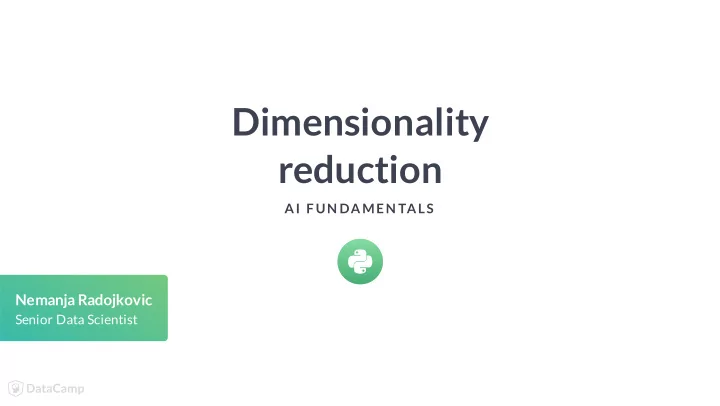

Dimensionality reduction AI F UN DAMEN TALS Nemanja Radojkovic Senior Data Scientist
De�nition "Dimensionality reduction is the process of reducing the number of variables under consideration by obtaining a set of principal variables." AI FUNDAMENTALS
Why? Pro's Reduce over�tting Obtain independent features Lower computational intensity Enable visualization Con's Compression => Loss of information => loss of performance AI FUNDAMENTALS
Types Feature selection (B ? A) Feature extraction (B ? A) Selecting a subset of existing features, Transforming and combining existing based on predictive power features into new ones. Non-trivial problem: Looking for the best Linear or non-linear projections . "team of features", not individually best features! AI FUNDAMENTALS
Common algorithms Linear (faster, deterministic) Non-linear (slower, non-deterministic) Principal Component Analysis (PCA) Isomap from sklearn.decomposition \ from sklearn.manifold import Isomap import PCA t-distributed Stochastic Neighbor Latent Dirichlet Allocation Embedding (t-SNE) from sklearn.decomposition \ from sklearn.manifold import TSNE import LatentDirichletAllocation AI FUNDAMENTALS
Principal Component Analysis (PCA) Family : Linear methods. Intuition : Principal components are directions of highest variability in data. Code example: Reduction = keeping only top #N principal components. from sklearn.decomposition import PCA Assumption: Normal distribution of data. pca = PCA(n_dimensions=3) Caveat: Very sensitive to outliers. X_reduced = pca.fit_transform(X) AI FUNDAMENTALS
Use it wisely! AI F UN DAMEN TALS
Clustering AI F UN DAMEN TALS Nemanja Radojkovic Senior Data Scientist
What is clustering? Cluster = Group of entities or events sharing similar attributes. Clustering (AI) = The process of applying Machine Learning algorithms for automatic discovery of clusters. AI FUNDAMENTALS
Popular clustering algorithms KMeans clustering from sklearn.cluster import KMeans Spectral clustering from sklearn.cluster import SpectralClustering DBSCAN from sklearn.cluster import DBSCAN AI FUNDAMENTALS
AI FUNDAMENTALS
AI FUNDAMENTALS
AI FUNDAMENTALS
How many clusters do I have? –> Elbow method! AI FUNDAMENTALS
How many clusters do I have? AI FUNDAMENTALS
Cluster analysis and tuning Unsupervised (no "ground truth", no expectations) Variance Ratio Criterion: sklearn.metrics.calinski_harabaz_score "What is the average distance of each point to the center of the cluster AND what is the distance between the clusters?" Silhouette score: sklearn.metrics.silhouette_score "How close is each point to its own cluster VS how close it is to the others?" Supervised ("ground truth"/expectations provided) Mutual information (MI) criterion: sklearn.metrics.mutual_info_score Homogeneity score: sklearn.metrics.homogeneity_score AI FUNDAMENTALS
Explore, experiment and tune! AI F UN DAMEN TALS
Anomaly detection AI F UN DAMEN TALS Nemanja Radojkovic Senior Data Scientist
De�nition and use cases Detecting unusual entities or events. Hard to de�ne what's odd, but possible to de�ne what's normal. Use cases Credit card fraud detection Network security monitoring Heart-rate monitoring AI FUNDAMENTALS
Approaches: Thresholding AI FUNDAMENTALS
Approaches: Rate of change AI FUNDAMENTALS
Approaches: Shape monitoring AI FUNDAMENTALS
Algorithms Robust covariance (assumes normal distribution) from sklearn.covariance import EllipticEnvelope Isolation Forest (powerful, but more computationally demanding) from sklearn.ensemble import IsolationForest One-Class SVM (sensitive to outliers, many false negatives) from sklearn.svm import OneClassSVM AI FUNDAMENTALS
AI FUNDAMENTALS
Training and testing Example: Isolation Forest from sklearn.ensemble import IsolationForest algorithm = IsolationForest() # Fit the model algorithm.fit(X) # Apply the model and detect the outliers results = algorithm.predict(X) AI FUNDAMENTALS
Evaluation Example: Arrhythmia detection from sklearn.metrics \ import (confusion_matrix, precision_score, recall_score) confusion_matrix(y_true, y_predicted) Precision = How many of the anomalies I have detected are TRUE anomalies? Recall = How many of the TRUE anomalies I have managed to detect? AI FUNDAMENTALS
Want to learn more? AI F UN DAMEN TALS
Selecting the right model AI F UN DAMEN TALS Nemanja Radojkovic Senior Data Scientist
Model-to-problem �t Type of Learning Target variable de�ned & known? => Supervised. Classi�cation? Regression No target variable, exploration? => Unsupervised. Dimensionality Reduction? Clustering? Anomaly Detection? AI FUNDAMENTALS
De�ning the priorities Interpretable models Linear regression (Linear, Logistic, Lasso, Ridge) Decision Trees Well performing models Tree ensembles (Random Forests, Gradient Boosted Trees) Support Vector Machines Arti�cial Neural Networks Simplicity �rst! AI FUNDAMENTALS
Using multiple metrics Satisfying metrics Cut-off criteria that every candidate model needs to meet. Multiple satisfying metrics possible (e.g. minimum accuracy, maximum execution time, etc) Optimizing metrics Illustrates the ultimate business priority (e.g. "minimize false positives", "maximize recall") "There can be only one" Final model: Passes the bar on all satisfying metrics and has the best score on the optimization metric. AI FUNDAMENTALS
Interpretation Global "What are the general decision-making rules of this model?" Common approaches: Decision tree visualization Feature importance plot Local "Why was this speci�c example classi�ed in this way?" LIME algorithm (Local Interpretable Model-Agnostic Explanations) AI FUNDAMENTALS
Model selection and interpretation AI F UN DAMEN TALS
Recommend
More recommend